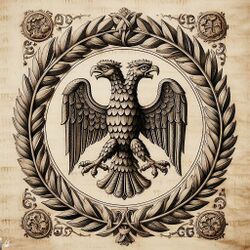Venceian Republic
This article is a work-in-progress because it is incomplete and pending further input from an author. Note: The contents of this article are not considered canonical and may be inaccurate. Please comment on this article's talk page to share your input, comments and questions. |
Venceian Republic
| |||||||||
|---|---|---|---|---|---|---|---|---|---|
| 1172-1283 | |||||||||
| Status | Republic | ||||||||
| Capital | Venceia | ||||||||
| Common languages |
| ||||||||
| Religion | Catholic | ||||||||
| Government | Oligarchic republic | ||||||||
| Legislature | Senate | ||||||||
| |||||||||
The Second Caphiric Republic, usually referred to by the historiographical convention of the Venceian Republic refers to the era of Caphirian history spanning 1172-1283. After a series of civil wars and disasters destabilized the Second Imperium and led to the death of the final Imperator of that regime, the Senatorial patrician class stepped into the power vacuum and established an oligarchical republic in its place. The new Republic was intended to spread power widely among the patricians but also ensure a power-sharing system which would prevent civil war. The establishment of the republic marked the formal end of the Second Imperium, and due to the series of catastrophic events in the years leading up to its establishing, the territory of the Republic was significantly smaller than that of the Second Imperium.
Despite its limited initial geographic footprint - largely equivalent to the modern provinces of Amarsia, Leonia, Inonsia, Misena, Carina, Alcarca, Estro and part of Narico - the Republic managed to restore political stability and end economic chaos in the area immediately surrounding Venceia during its initial decades. By the beginning of the 13th century, the Republic was stable and economically prosperous, but still retained a significantly reduced ability to project power. The Republic did manage to reclaim some territory, largely under the authority of nominal governors such as Sebastián Pasillas. Using this system, as well as conventional military aims, the Republic reached its zenith in around 1235 before entering a five decade period of decline. The Republic and its allies and governors were unable to stop the rise of Slavic power in southern Sarpedon. Following decades of wars, Serossaccir Odobricci ultimately defeated the Republic in 1283. He induced the government and Senate of the Republic to recognize him as Imperator, establishing the Third Imperium.
Nomenclature
Various terms have been used to describe the Caphiric state in the periods between the Second and Third Imperium. Contemporary scholars continued to use the term "the state" or "the republic", terms which were also used during the First and Second Imperiums to refer generically to the Caphiric government. Post-Second Imperium histories briefly used terms like the "interregnal republic" before adopting the convention "Venceian Republic" beginning in the 15th century. The purpose of this term was to delegitimize and deassociate the Republic from Caphiria's overall identity and history, largely for political purpose which emphasized the legitimacy and necessity of an Imperator-led system. These connotations evolved into a full rejection of the Republic's legacy by the 19th century, and many Caphirian histories did not cover the 1172-1283 period at all. This version of events was generally accepted globally through the mid-20th century, when Levantine scholarship began to emphasize the continuity of the Caphiric state. Accordingly, the term Venceian Republic remains in use in popular parlance but the term "Second Republic" is heavily preferred by scholars outside Sarpedon.
History
Government
The Venceian Republic was an oligarchic republic. It empowered the existing structure of magistrates to serve as its government. Although popular belief and initial scholarly views were that the Venceian Republic restored the system of government used by the First Republic, most modern scholars now argue that the Venceian Republic used the heavily modified Imperator-based magistrate system, effectively continuing the government of the Second Imperium without an Imperator. Accordingly, it was the Princeps Senatus rather than Consuls who served as the primary head of government, serving at the pleasure of the Senate. The Princeps Senatus was responsible for day-to-day governance of the Republic in conjunction with the Senate, who often appointed three or four-person executive committees to serve under his jurisdiction and direct the affairs of senior magistrates. The Princeps Senatus was responsible for appointing Consuls to serve as military leaders, effectively replacing the Imperator in that regard. The head of state role evolved over the course of the Republic's life. A "State Praetor" serving two year terms was initially invested to serve the ceremonial function of the Imperator while the Princeps Senatus held political power and the Consuls military power. This powerless figurehead role gradually lost significance, and it appears that no State Praetor was appointed at all in the final thirty years of the Republic's existence. In the aftermath, some of these ceremonial functions reverted to the Senate as a whole, the Princeps Senatus individually, or fell out of favor as the government tried to foster republican ideals within the culture.
